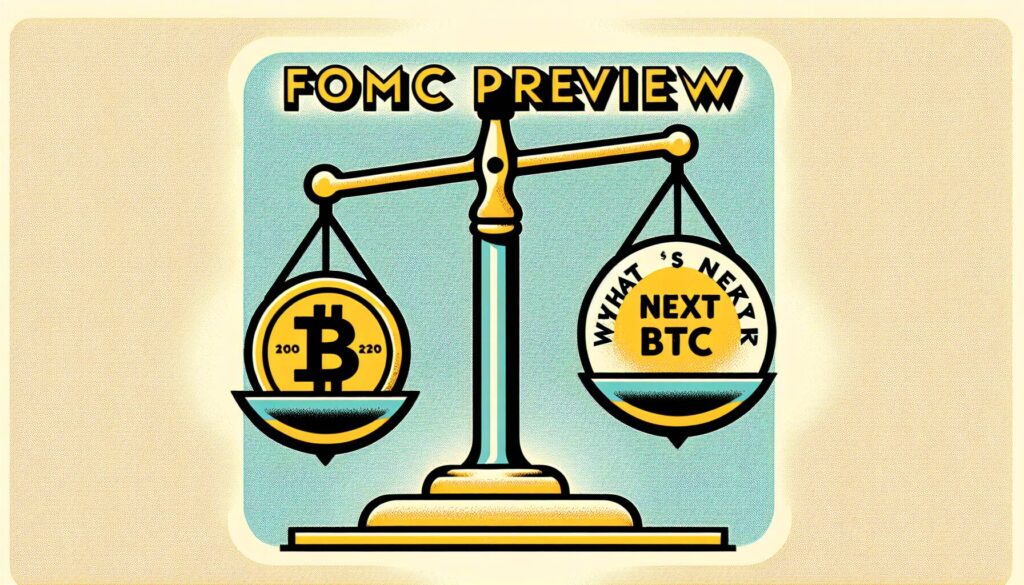The cryptocurrency market is seeing some notable fluctuations as Bitcoin and other digital assets edge lower in anticipation of the Federal Reserve’s upcoming rate decision. In recent days, both Bitcoin and Ethereum have experienced declines, raising concerns among investors about market volatility amidst macroeconomic uncertainty.
As anticipation builds around the Fed’s meeting, analysts have noted that rising interest rates could dampen investor sentiment toward cryptocurrencies, which are often seen as riskier assets. With BTC prices feeling the pressure, many are left wondering what factors are contributing to this downward trend and what it might take for these digital currencies to regain their footing.
“What will it take for Bitcoin to reverse recent losses?” asks a piece featured on Yahoo Finance, hinting at the growing unease in the cryptocurrency community.
Additionally, reports from sources like CNBC and CoinDesk highlight a broader market trend where even popular tokens like XRP and Dogecoin have succumbed to selling pressure. These outcomes raise questions about what might be blocking a potential rebound in the crypto markets.
As the financial landscape shifts, crypto aficionados and casual investors alike are closely monitoring these developments, eager to uncover the underlying dynamics affecting prices. The interplay between regulatory decisions and market behavior will undoubtedly shape the trajectory of digital currencies in the coming days.

FOMC Preview: Bitcoin Price (BTC) Heads Lower
The current state of the cryptocurrency market, particularly Bitcoin and other major coins, is influenced by several factors. Here are the key points derived from the recent discussions and analyses:
- Federal Reserve’s Rate Decision
- The upcoming FOMC meeting may lead to monetary policy changes that affect investor sentiment in the cryptocurrency market.
- Rate hikes generally strengthen the US dollar, potentially diminishing demand for cryptocurrencies as alternative assets.
- Price Declines of Major Cryptocurrencies
- Bitcoin, Ethereum, and XRP have recently experienced declines, which may signal bearish trends in the market.
- Ethereum’s performance is particularly correlated with Bitcoin’s price movements, impacting overall market dynamics.
- Investor Caution
- Heightened caution among investors due to macroeconomic factors could lead to further declines in crypto prices.
- Many traders may be awaiting concrete signals from the Fed before making new investments.
- Rebound Potential
- The market is questioning what conditions would allow Bitcoin to reverse its recent losses, signaling uncertainty among investors.
- Indicators such as increased adoption, institutional interest, or favorable regulatory news could trigger a market rebound.
- Market Sentiment
- Overall market sentiment appears to be bearish as economic factors weigh heavily on traders’ decisions.
- Emotional factors influenced by these economic conditions, such as fear and uncertainty, often drive volatility in cryptocurrency prices.
The implications of these points are significant for both seasoned and new investors. Understanding the interplay of economic indicators and consumer sentiment is crucial for making informed decisions in the often-volatile cryptocurrency market.
Analyzing the Current State of Bitcoin Amid Fed Decisions
The latest buzz around Bitcoin is undeniably stamped by concerns over the Federal Reserve’s impending rate decision. With coin values such as Bitcoin and Ethereum already feeling the pressure, the prevailing sentiment across the crypto landscape reflects uncertainty. This backdrop provides fertile ground for a comparative analysis of how different news outlets frame the situation and the potential impacts on various stakeholders.
Competitive Advantages: Platforms like CoinDesk and CNBC are leveraging timely reporting on market fluctuations to keep their audience informed. Their adeptness at correlating Fed policy reviews with cryptocurrency pricing can help investors and crypto enthusiasts anticipate market movements, making these platforms essential resources for anyone looking to navigate this volatile market. They also highlight broader economic indicators, providing a well-rounded understanding of how macroeconomic factors influence cryptocurrencies.
In contrast, Barron’s and The Motley Fool dive deeper into the psychological and technical barriers preventing a rebound in prices. By focusing on external factors that hinder market recovery, these platforms cater to readers who may want insights beyond the numeric price shifts. Such approaches can foster a more sophisticated investor base that appreciates fundamental analysis alongside market reporting.
Competitive Disadvantages: However, outlets like CNBC may sometimes lean heavily on sensationalism, which could lead to misinterpretations among novice investors. Emphasizing panic and decline might deter risk-averse individuals who could otherwise participate in a recovery phase. Issues arise when sensational reporting creates a feedback loop of negative sentiment, further deflating investor confidence.
Potential Beneficiaries and Challenges: The current situation particularly benefits seasoned traders who capitalize on volatility. With decreasing prices, savvy investors may find opportunities for strategic buy-ins. On the flip side, less experienced individuals or those heavily invested in long-term holdings might face challenges as they navigate the turbulent waters of market sentiment sparked by shifting interest rates.
In summary, while reputable sources provide valuable insights and cater to different audience needs, the inherent volatility and broad economic influences can create both opening avenues for savvy investors and cautionary tales for the environment surrounding Bitcoin and other digital assets.

















